Hybridization of PSO for the Optimal Coordination of Directional Overcurrent Protection Relays
Abstract
:1. Introduction
2. Problem Formulating of DOPR
Formulation of Constraints
3. HPSO Algorithm for DOPR Estimation
4. Simulation Results of Different Cases of DOPR
4.1. Single-Ended Power Distribution System (Case 1)
4.2. Single-Ended Parallel Distribution Power System (Case 2)
4.3. Multi-Loop Parallel Distribution Power System (Case 3)
4.4. Multi-Loop Parallel Distribution Power System (Case 4)
4.5. IEEE 3-Bus System (Case 5)
5. Comparison Results Analysis
6. Conclusions
Author Contributions
Funding
Data Availability Statement
Conflicts of Interest
References
- Blackburn, J. Protective Relaying, Principles and Applications; Marcel Dekker Inc.: New York, NY, USA, 1987. [Google Scholar]
- Khurshaid, T.; Wadood, A.; Farkoush, S.G.; Yu, J.; Kim, C.H.; Rhee, S.B. An improved optimal solution for the directional overcurrent relays coordination using hybridized whale optimization algorithm in complex power systems. IEEE Access 2019, 7, 90418–90435. [Google Scholar] [CrossRef]
- Irfan, M.; Wadood, A.; Khurshaid, T.; Khan, B.M.; Kim, K.C.; Oh, S.R.; Rhee, S.B. An Optimized Adaptive Protection Scheme for Numerical and Directional Overcurrent Relay Coordination Using Harris Hawk Optimization. Energies 2021, 14, 5603. [Google Scholar] [CrossRef]
- Haider, Z.M.; Mehmood, K.K.; Khan, S.U.; Khan, M.O.; Wadood, A.; Rhee, S.B. Optimal Management of a Distribution Feeder during Contingency and Overload Conditions by Harnessing the Flexibility of Smart Loads. IEEE Access 2021, 9, 40124–40139. [Google Scholar] [CrossRef]
- Bukhari, A.S.B.; Mehmood, K.K.; Wadood, A.; Park, H. Intelligent Islanding Detection of Microgrids Using Long Short-Term Memory Networks. Energies 2021, 14, 18. [Google Scholar] [CrossRef]
- Wadood, A.; Khurshaid, T.; Farkoush, S.G.; Kim, C.H.; Rhee, S.B. A bio-inspired rooted tree algorithm for optimal coordination of overcurrent relays. In International Conference on Intelligent Technologies and Applications; Springer: Singapore, 2018; pp. 188–201. [Google Scholar]
- Shih, M.Y.; Enríquez, A.C.; Martín, L.; Trevi, T. On-line coordination of directional overcurrent relays: Performance evaluation among optimization algorithms. Electr. Power Syst. Res. 2014, 110, 122–132. [Google Scholar] [CrossRef]
- Yang, H.; Wen, F.; Ledwich, G. Optimal coordination of overcurrent relays in distribution systems with distributed generators based on differential evolution algorithm. Int. Trans. Elect. Energy Syst. 2013, 23, 1–12. [Google Scholar] [CrossRef]
- Gokhale, S.S.; Kale, V.S. An application of a tent map initiated Chaotic Firefly algorithm for optimal overcurrent relay coordination. Int. J. Electr. Power Energy Syst. 2016, 78, 336–342. [Google Scholar] [CrossRef]
- Khurshaid, T.; Wadood, A.; Farkoush, S.G.; Kim, C.H.; Yu, J.; Rhee, S.B. Improved firefly algorithm for the optimal coordination of directional overcurrent relays. IEEE Access 2019, 7, 78503–78514. [Google Scholar] [CrossRef]
- Singh, M.; Panigrahi, B.K.; Abhyankar, A.R.; Das, S. Optimal coordination of directional over-current relays using informative differential evolution algorithm. J. Comput. Sci. 2014, 5, 269–276. [Google Scholar] [CrossRef]
- Chelliah, T.R.; Thangaraj, R.; Allamsetty, S.; Pant, M. Coordination of directional overcurrent relays using opposition based chaotic differential evolution algorithm. Int. J. Electr. Power Energy Syst. 2014, 55, 341–350. [Google Scholar] [CrossRef]
- Bedekar, P.P.; Bhide, S.R. Optimum coordination of directional overcurrent relays using the hybrid GA-NLP approach. IEEE Trans. Power Deliv. 2011, 26, 109–119. [Google Scholar] [CrossRef]
- Razavi, F.; Abyaneh, H.A.; Al-Dabbagh, M.; Mohammadi, R.; Torkaman, H. A new comprehensive genetic algorithm method for optimal overcurrent relays coordination. Electr. Power Syst. Res. 2008, 78, 713–720. [Google Scholar] [CrossRef]
- GholamiFarkoush, S.; Khurshaid, T.; Wadood, A.; Kim, C.-H.; Kharal, K.H.; Kim, K.-H.; Cho, N.; Rhee, S.-B. Investigation and Optimization of Grounding Grid Based on Lightning Response by Using ATP-EMTP and Genetic Algorithm. Complexity 2018, 2018, 1–8. [Google Scholar] [CrossRef]
- Bedekar, P.P.; Bhide, S.R. Optimum coordination of overcurrent relay timing using continuous genetic algorithm. Expert Syst. Appl. 2011, 38, 11286–11292. [Google Scholar] [CrossRef]
- Moravej, Z.; Adelnia, F.; Abbasi, F. Optimal coordination of directionalovercurrent relays using NSGA-II. Electr. Power Syst. Res. 2015, 119, 228–236. [Google Scholar] [CrossRef]
- Bhattacharya, S.K.; Goswami, S.K. Distribution network reconfiguration considering protection coordination constraints. Electr. Power Compon. Syst. 2008, 36, 1150–1165. [Google Scholar] [CrossRef]
- Abhyaneh, H.A.; Al-Dabbagh, M.; Karegar, H.K.; Sadeghi, S.H.H.; Khan, R.A.J. A new optimal approach for coordination of directional overcurrent relays in interconnected power system. IEEE Trans. Power Deliv. 2003, 18, 430–435. [Google Scholar] [CrossRef]
- Wadood, A.; Kim, C.-H.; Khurshiad, T.; Farkoush, S.G.; Rhee, S.-B. Application of a continuous particle swarm optimization (CPSO) for the optimal coordination of overcurrent relays considering a penalty method. Energies 2018, 11, 869. [Google Scholar] [CrossRef] [Green Version]
- Ghanbari, M.; Gandomkar, M.; Nikoukar, J. Protection Coordination of Bidirectional Overcurrent Relays Using Developed Particle Swarm Optimization Approach Considering Distribution Generation Penetration and Fault Current Limiter Placement. IEEE Can. J. Electr. Comput. Eng. 2021, 44, 2. [Google Scholar] [CrossRef]
- Khurshaid, T.; Wadood, A.; Farkoush, S.G.; Kim, C.-H.; Cho, N.; Rhee, S.-B. Modified particle swarm optimizer as optimization of time dial settings for coordination of directional overcurrent relay. J. Elect. Eng. Technol. 2019, 14, 55–68. [Google Scholar] [CrossRef]
- Mosavi, S.M.A.; Kejani, T.A.; Javadi, H. Optimal setting of directional over-current relays in distribution networks considering transient stability. Int. Trans. Electr. Energy Syst. 2015, 26, 122–133. [Google Scholar] [CrossRef]
- Kim, C.-H.; Khurshaid, T.; Wadood, A.; Farkoush, S.G.; Rhee, S.B. Gray wolf optimizer for the optimal coordination of directional overcurrent relay. J. Electr. Eng. Technol. 2018, 13, 1043–1051. [Google Scholar]
- Castillo, C.; Conde, A.; Shih, M. Improvement of non-standardized directional overcurrent relay coordination by invasive weed optimization. Electr. Power Syst. Res. 2018, 157, 48–58. [Google Scholar] [CrossRef]
- Bouchekara, H.; Zellagui, M.; Abido, M. Optimal coordination of directional overcurrent relays using a modified electromagnetic field optimization algorithm. Appl. Soft Comput. 2017, 54, 267–283. [Google Scholar] [CrossRef]
- Wadood, A.; Farkoush, S.G.; Khurshaid, T.; Yu, J.-T.; Kim, C.-H.; Rhee, S.-B. Application of the JAYA Algorithm in Solving the Problem of the Optimal Coordination of Overcurrent Relays in Single- and Multi-Loop Distribution Systems. Complexity 2019, 2019, 1–13. [Google Scholar] [CrossRef]
- Yu, J.-T.; Kim, C.-H.; Wadood, A.; Khurshaid, T.; Rhee, S.-B. Jaya Algorithm With Self-Adaptive Multi-Population and Lévy Flights for Solving Economic Load Dispatch Problems. IEEE Access 2019, 7, 21372–21384. [Google Scholar] [CrossRef]
- Yu, J.; Kim, C.-H.; Wadood, A.; Khurshiad, T.; Rhee, S.-B. A Novel Multi-Population Based Chaotic JAYA Algorithm with Application in Solving Economic Load Dispatch Problems. Energies 2018, 11, 1946. [Google Scholar] [CrossRef] [Green Version]
- Wadood, A.; Khurshaid, T.; Gholami Farkoush, S.; Yu, J.; Kim, C.-H.; Rhee, S.-B. Nature-Inspired Whale Optimization Algorithm for Optimal Coordination of Directional Overcurrent Relays in Power Systems. Energies 2019, 12, 2297. [Google Scholar] [CrossRef] [Green Version]
- Wadood, A.; Gholami Farkoush, S.; Khurshaid, T.; Kim, C.-H.; Yu, J.; Geem, Z.W.; Rhee, S.-B. An Optimized Protection Coordination Scheme for the Optimal Coordination of Overcurrent Relays Using a Nature-Inspired Root Tree Algorithm. Appl. Sci. 2018, 8, 1664. [Google Scholar] [CrossRef] [Green Version]
- Rashedi, E.; Nezamabadi-Pour, H.; Saryazdi, S. GSA: A Gravitational Search Algorithm. Inf. Sci. 2009, 179, 2232–2248. [Google Scholar] [CrossRef]
- El-Naggar, K.; AlRashidi, M.; AlHajri, M.; Al-Othman, A. Simulated Annealing algorithm for photovoltaic parameters identification. Sol. Energy 2012, 86, 266–274. [Google Scholar] [CrossRef]
- Idoumghar, L.; Melkemi, M.; Schott, R.; Aouad, M.I. Hybrid PSO-SA type algorithms for multimodal function optimization and reducing energy consumption in embedded systems. Appl. Comput. Intell. Soft Comput. 2011, 2011, 138078. [Google Scholar] [CrossRef] [Green Version]
- Noghabi, A.S.; Sadeh, J.; Mashhadi, H.R. Considering different network topologies in optimal overcurrent relay coordination using a hybrid GA. IEEE Trans. Power Del. 2009, 24, 1857–1863. [Google Scholar] [CrossRef]
- Sadati, N.; Zamani, M.; Mahdavian, H.R.F. Hybrid particle swarm-based-simulated annealing optimization techniques. In Proceedings of the IECON 2006—32nd Annual Conference on IEEE Industrial Electronics, Paris, France, 6–10 November 2006. [Google Scholar]
- Zeienldin, H.; El-Saadany, E.F.; Salama, M.A. A Novel Problem Formulation for Directional Overcurrent Relay Coordination. In Proceedings of the Large Engineering Systems Conference on Power Engineering 2004 (LESCOPE-04), Halifax, NS, Canada, 28–30 July 2004; pp. 48–52. [Google Scholar]
- Urdaneta, A.J.; Restrepo, H.; Marquez, S.; Sanchez, J. Coordination of Directional Relay Timing using Linear Programming. IEEE Trans. Power Deliv. 1996, 11, 122–129. [Google Scholar] [CrossRef]
- Wadood, A.; Kim, C.-H.; Farkoush, S.G.; Rhee, S.B. An Adaptive Protective Coordination Scheme for Distribution System Using Digital Overcurrent Relays. In Proceedings of the Korean Institute of Illuminating and Electrical Installation Engineers, Gangwon, Korea, 30 August 2017; p. 53. [Google Scholar]
- Park, J.B.; Lee, K.S.; Shin, J.R.; Lee, K.Y. A Particle swarm optimization for economic dispatch with non-smooth cost functions. IEEE Trans. Power Syst. 2005, 20, 34–42. [Google Scholar] [CrossRef]
- Sevkli, M.; Guner, A.R. A continuous particle swarm optimization algorithm for uncapacitated facility location problem. In Ant Colony Optimization and Swarm Intelligence; Springer: Berlin/Heidelberg, Germany, 2006. [Google Scholar]
- Kirkpatrick, S.; Gellat, C.D.; Vecchi, M.P. Optimization by Simulated Annealing. Science 1983, 220, 671–680. [Google Scholar] [CrossRef]
- Bedekar, P.P.; Bhide, S.R.; Kale, V. Optimum Coordination of Overcurrent Relay Timing Using Simplex Method. Electr. Power Compon. Syst. 2010, 38, 1175–1193. [Google Scholar] [CrossRef]
- Bedekar, P.P.; Bhide, S.R.; Kale, V.S. Optimum coordination of over current relays in distribution system using dual simplex method. In Proceedings of the 2009 2nd International Conference on Emerging Trends in Engineering and Technology (ICETET), Nagpur, India, 16–18 December 2009. [Google Scholar]
- Bedekar, P.P.; Bhide, S.R.; Kale, V.S. Optimum time coordination of overcurrent relays using two phase simplex method. World Acad. Sci. Eng. Technol. 2009, 28, 1110–1114. [Google Scholar]
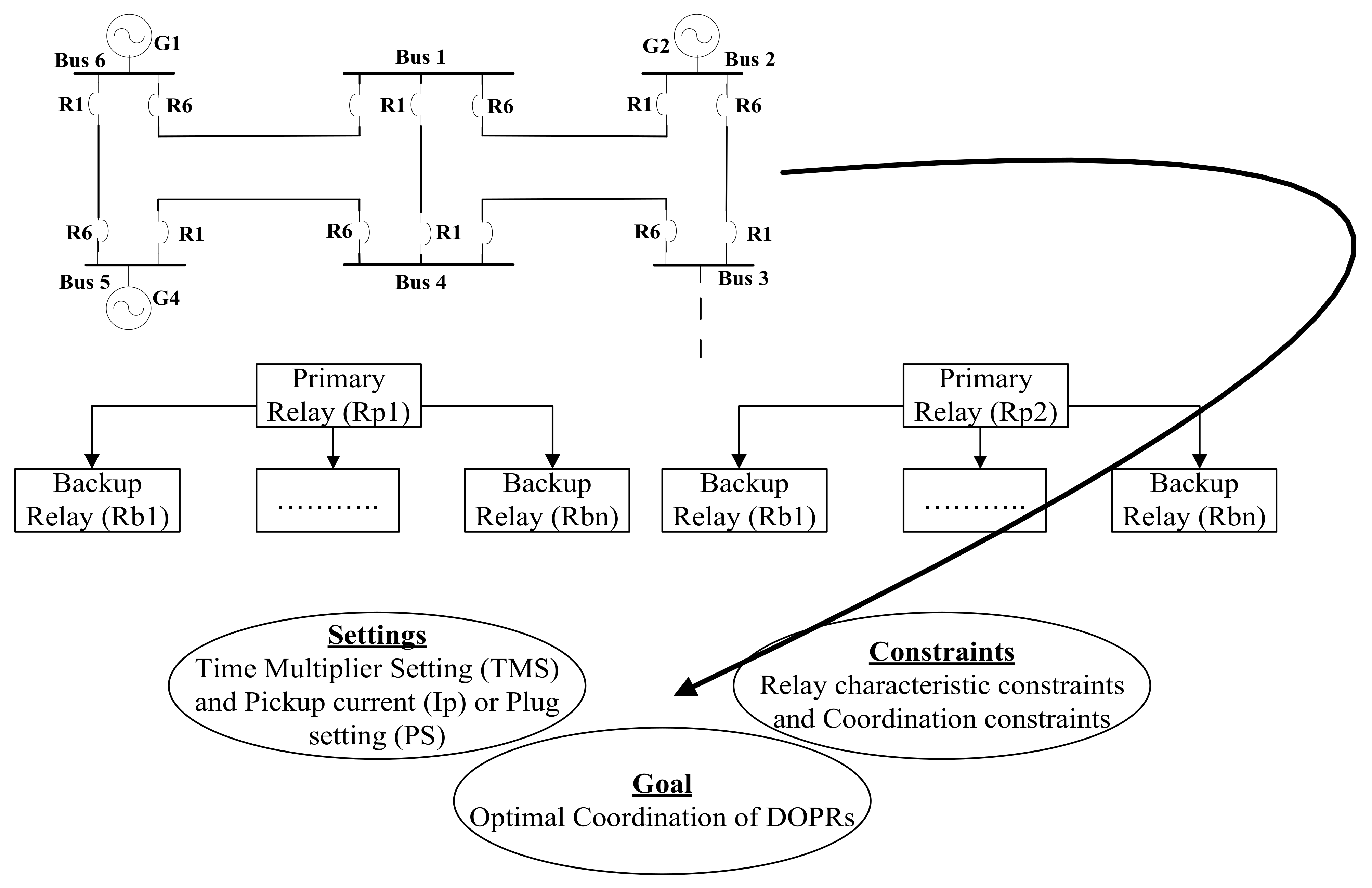


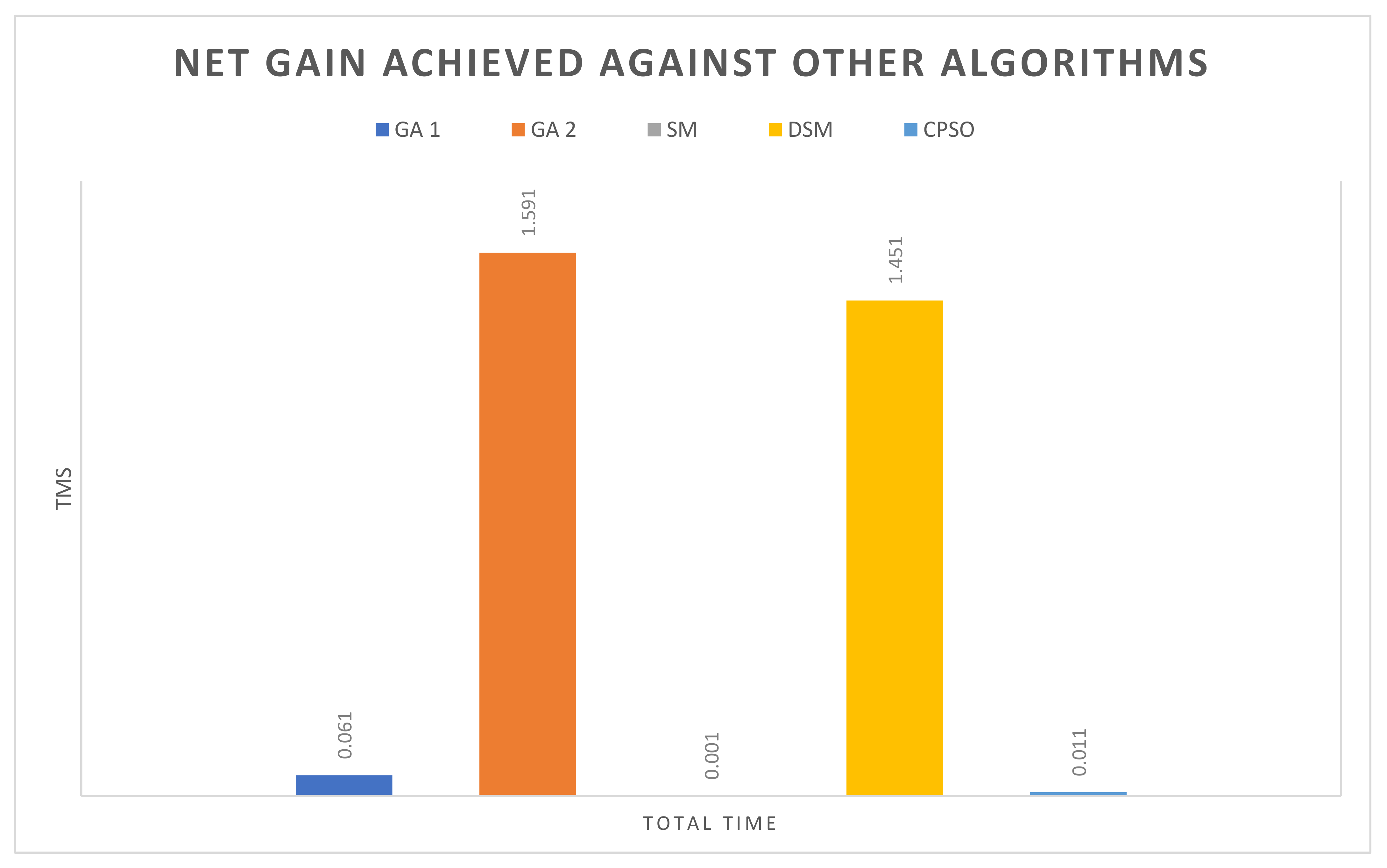
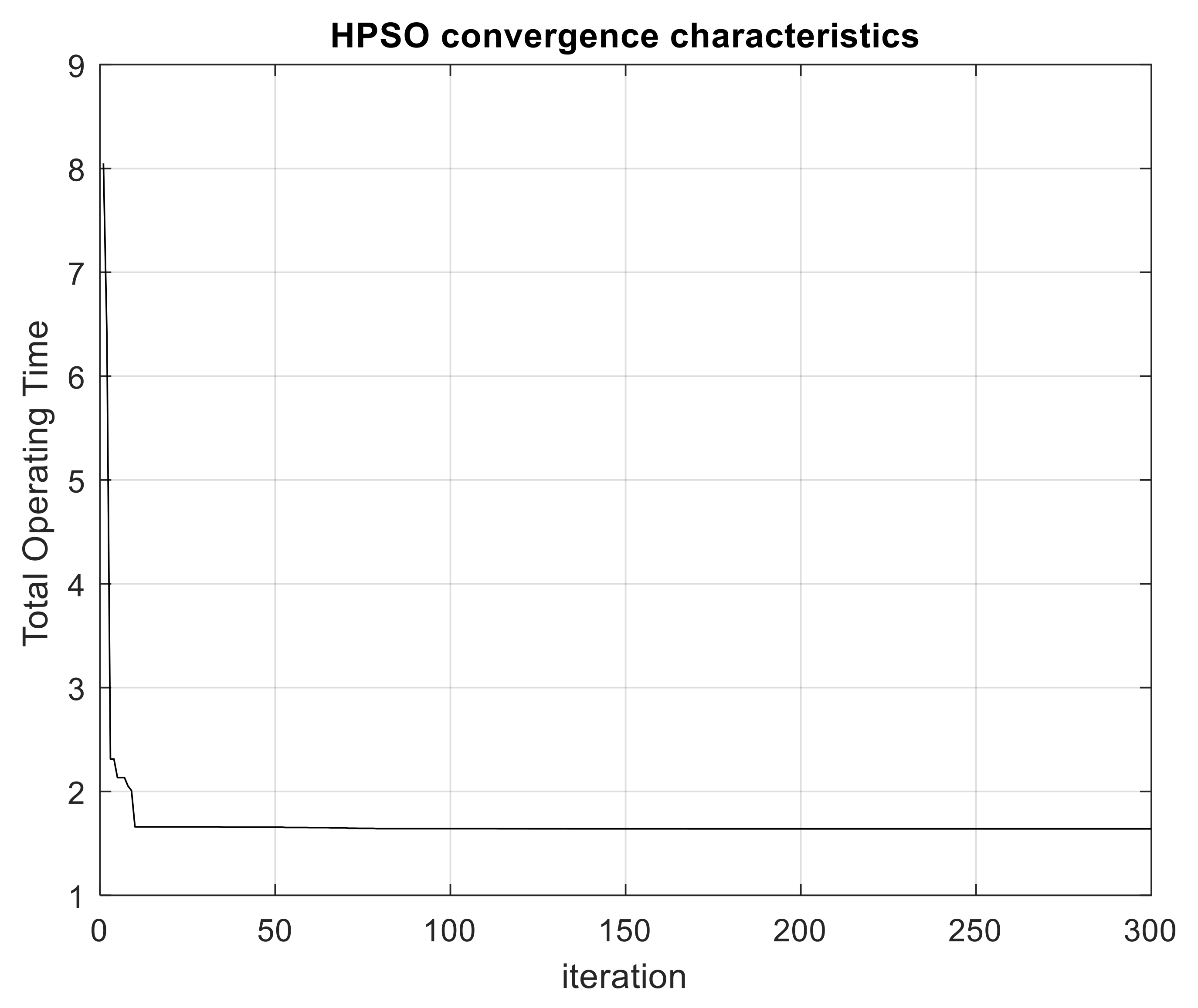





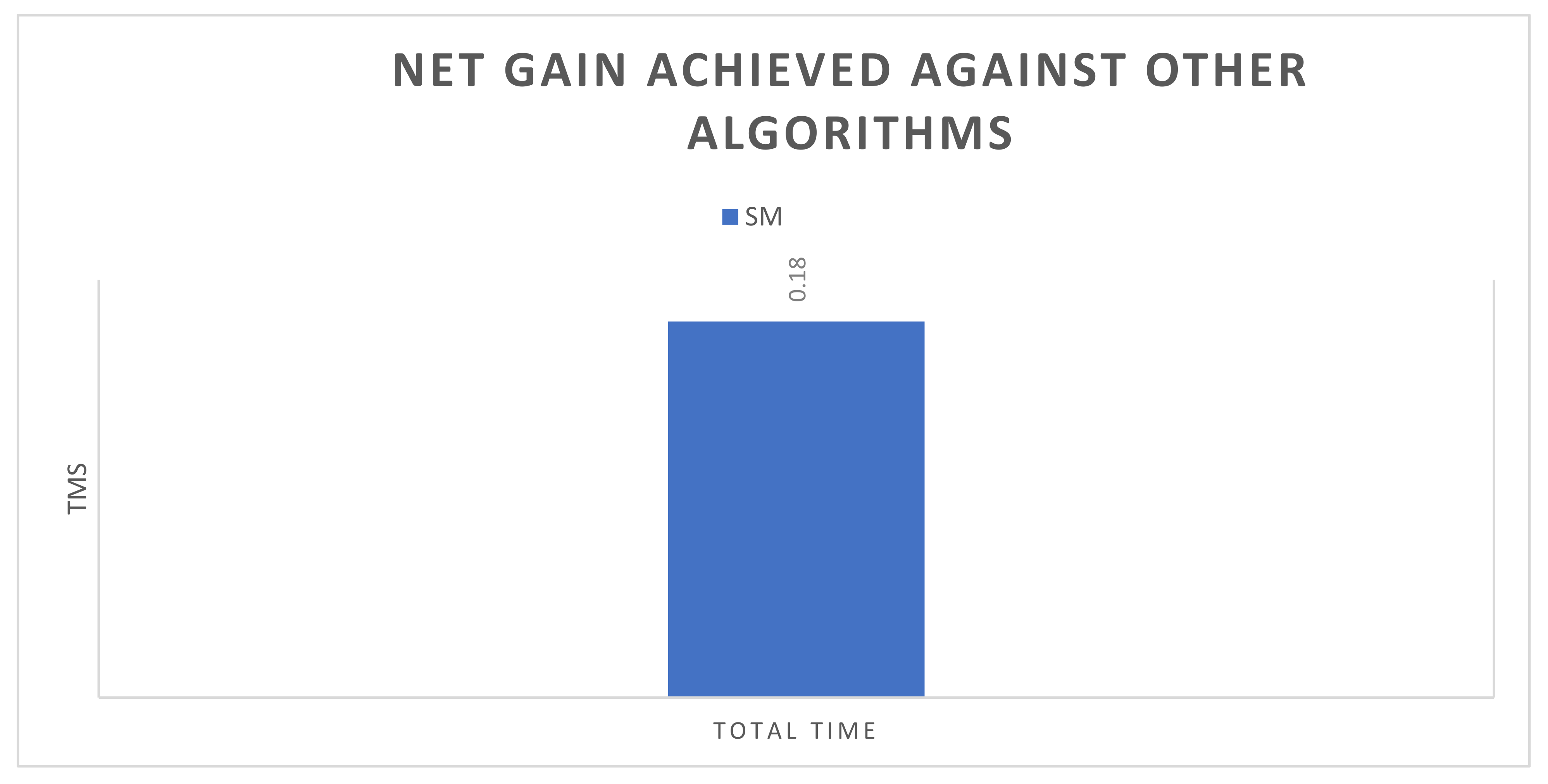
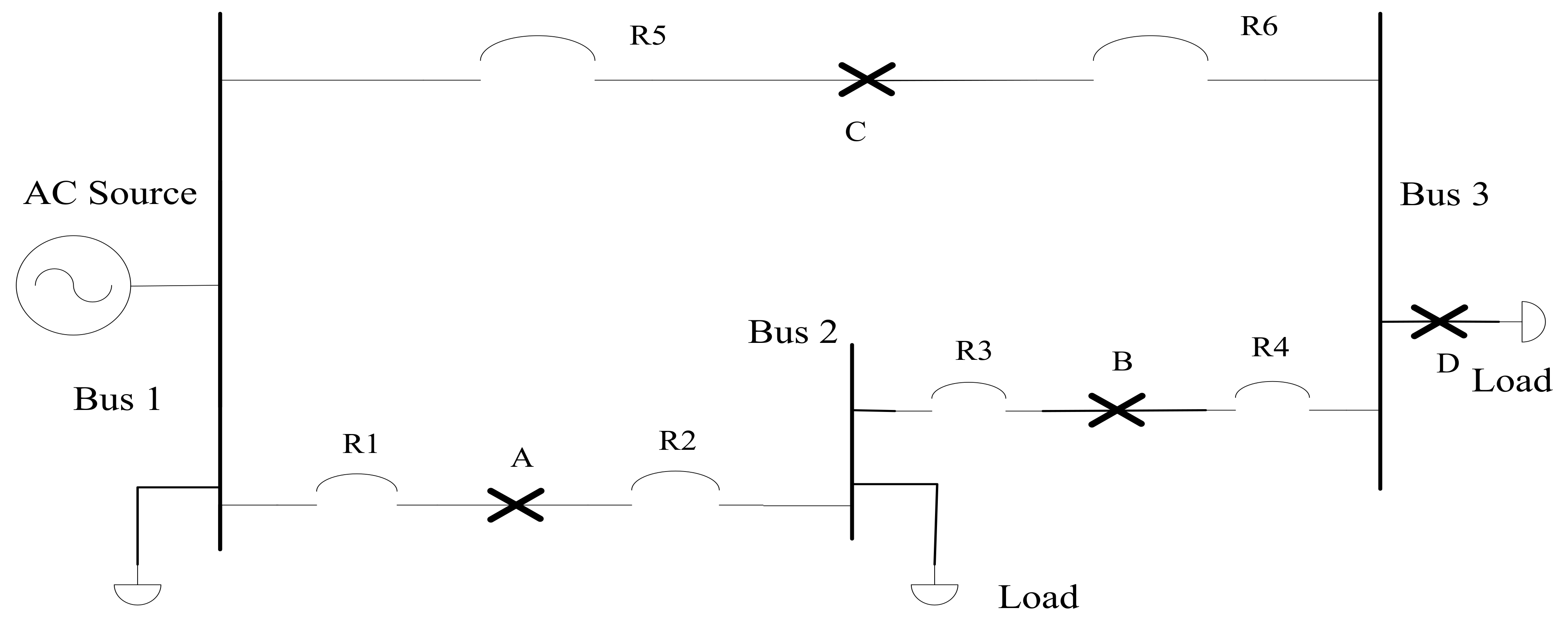
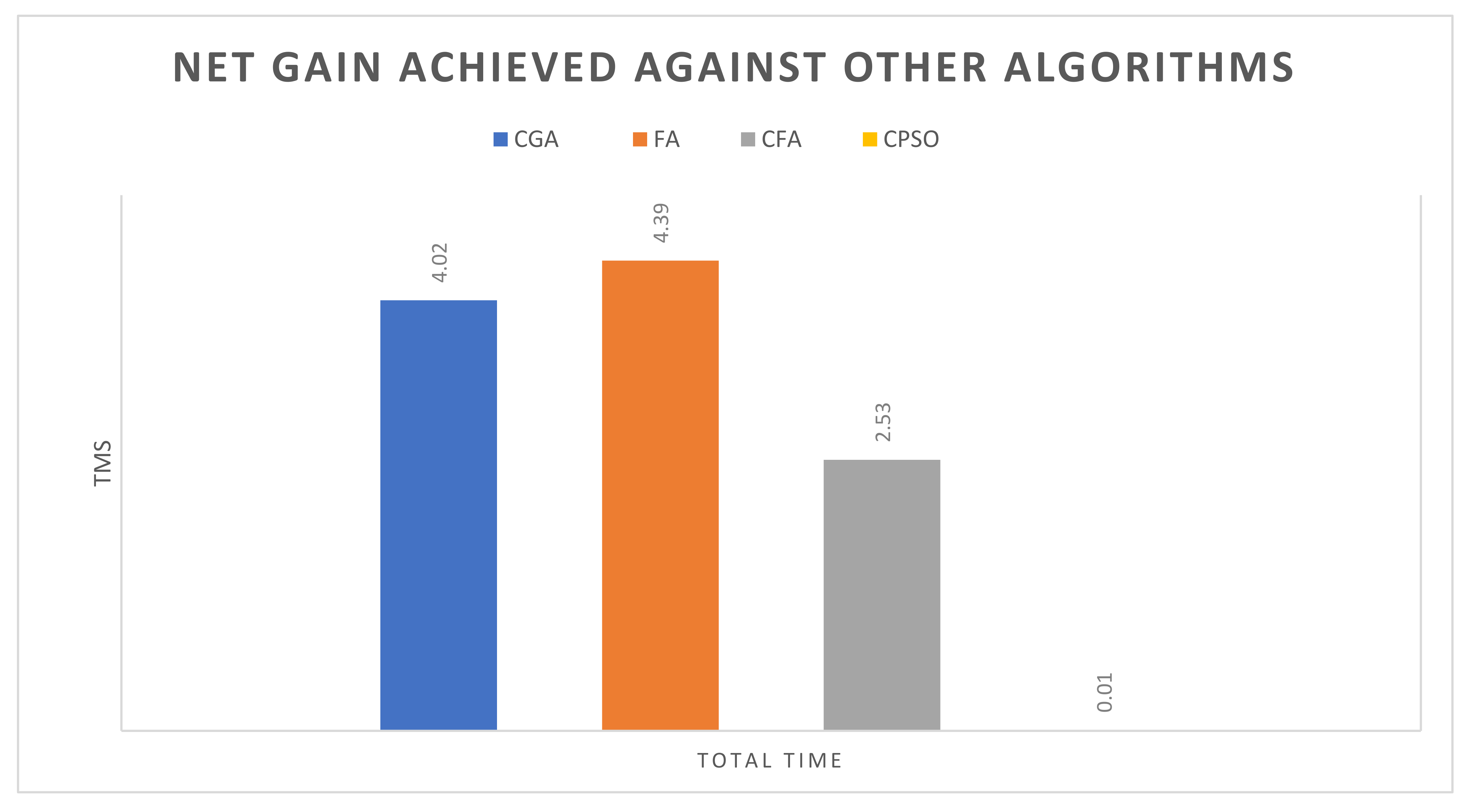
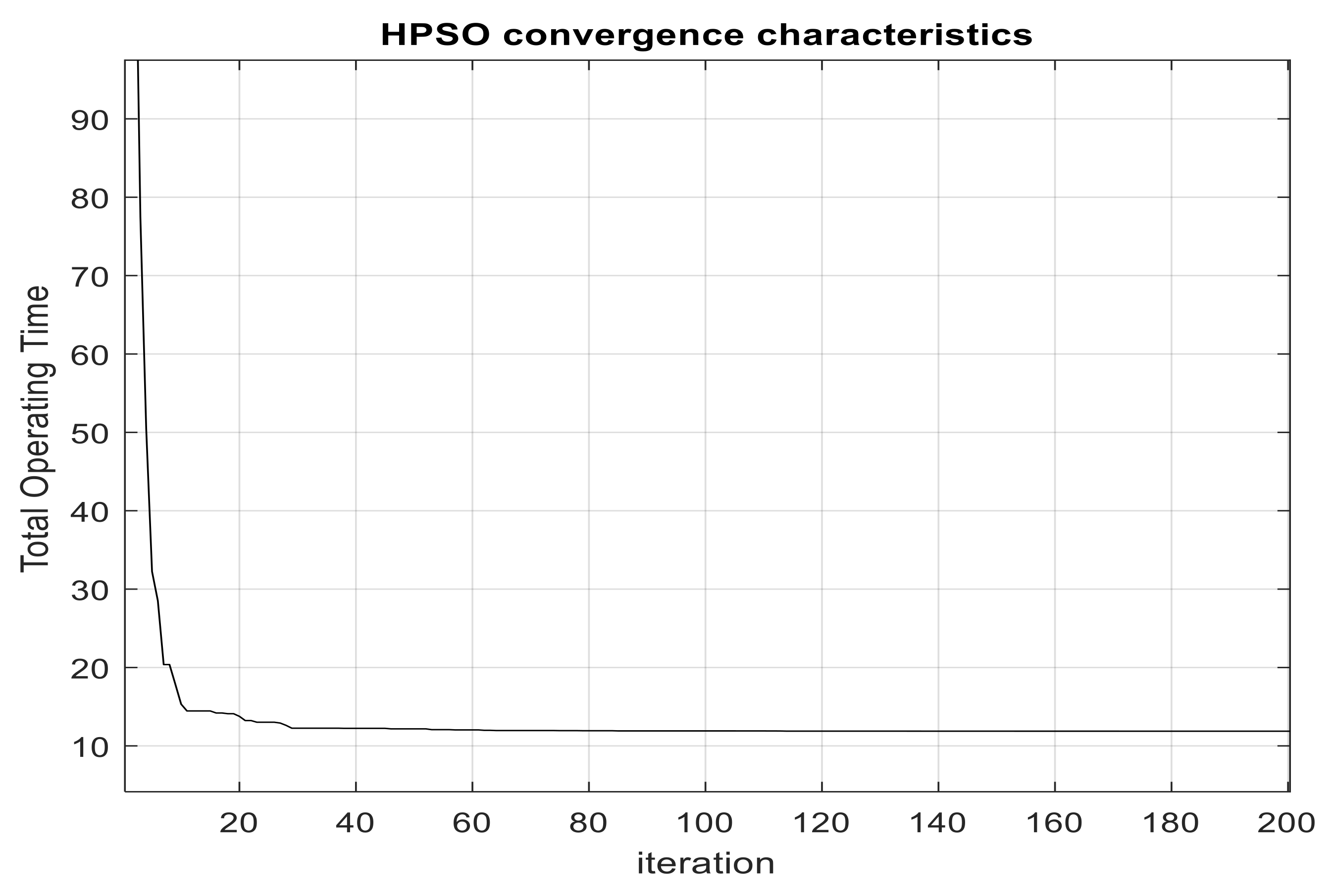
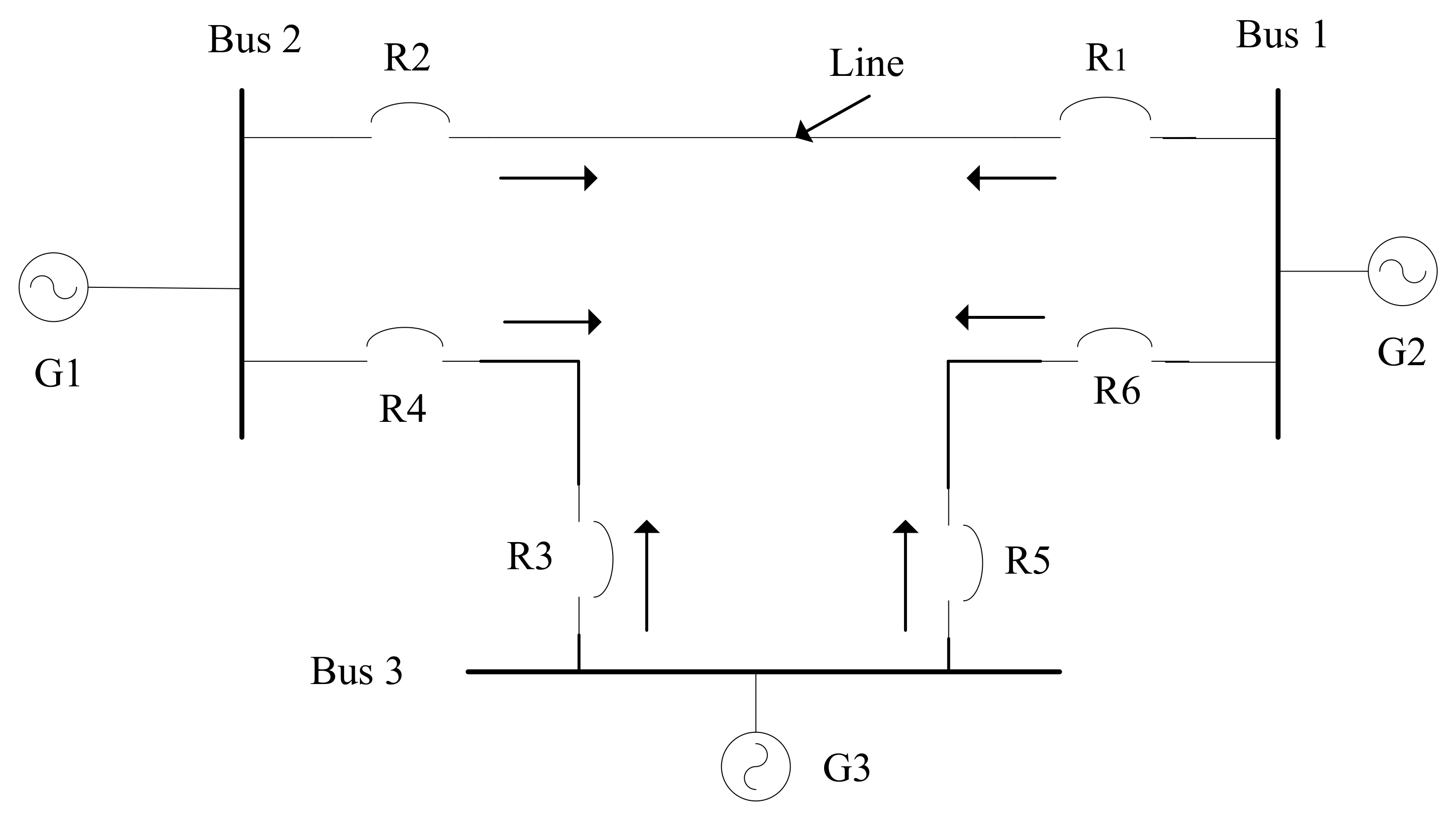

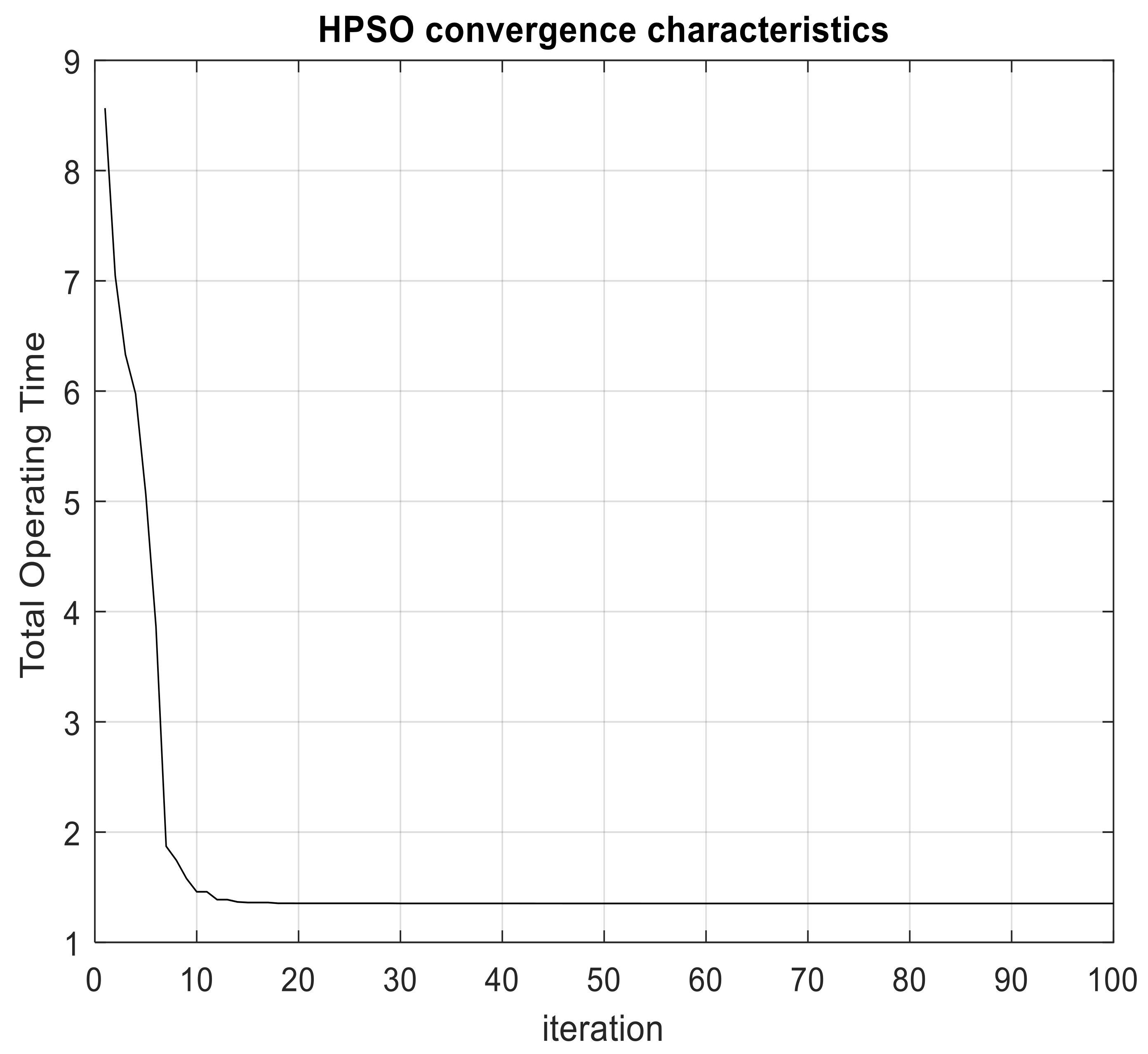
| Relay | CT Ratio | Plug Setting (PS) |
|---|---|---|
| R1 | 300:1 | 100% |
| R2 | 300:1 | 100% |
| R3 | 300:1 | 100% |
| R4 | 300:1 | 100% |
| Faulty Point | Relay | ||||
|---|---|---|---|---|---|
| 1 | 2 | 3 | 4 | ||
| A | Irelay | 10 | 3.33 | FNS | 3.33 |
| αp | 2.97 | 5.749 | FNS | 5.749 | |
| B | Irelay | 3.33 | FNS | 3.33 | 10 |
| αp | 5.749 | FNS | 5.749 | 2.97 | |
| TMS | GA 1 [43] | GA 2 [43] | SM [43] | DSM [44] | CPSO [20] | HPSO |
|---|---|---|---|---|---|---|
| TMS (Relay 1) | 0.081 | 0.168 | 0.07718 | 0.15 | 0.078 | 0.0771 |
| TMS (Relay 2) | 0.025 | 0.0250 | 0.0250 | 0.041 | 0.0250 | 0.0250 |
| TMS (Relay 3) | 0.025 | 0.0250 | 0.0250 | 0.041 | 0.0250 | 0.0250 |
| TMS (Relay 4) | 0.081 | 0.168 | 0.07718 | 0.15 | 0.078 | 0.0771 |
| Top[OF(s)] | 1.70 | 3.23 | 1.64 | 3.09 | 1.65 | 1.639 |
| Faulty Point | Relay | |||||
|---|---|---|---|---|---|---|
| 1 | 2 | 3 | 4 | 5 | ||
| A | Irelay | 9.059 | 3.019 | 3.019 | FNS | FNS |
| αp | 3.106 | 6.265 | 6.265 | FNS | FNS | |
| B | Irelay | 3.019 | FNS | 9.059 | 3.019 | FNS |
| αp | 6.265 | FNS | 3.106 | 6.265 | FNS | |
| C | Irelay | 4.875 | FNS | 4.875 | FNS | 29.25 |
| αp | 4.348 | FNS | 4.348 | FNS | 2.004 | |
| TMS | TPSM [45] | HPSO1 | FA [9] | CFA [9] | HPSO2 |
|---|---|---|---|---|---|
| TMS (Relay 1) | 0.069 | 0.071 | 0.032 | 0.032 | 0.0575 |
| TMS (Relay 2) | 0.025 | 0.018 | 0.016 | 0.047 | 0.0894 |
| TMS (Relay 3) | 0.069 | 0.071 | 0.121 | 0.091 | 0.0575 |
| TMS (Relay 4) | 0.025 | 0.018 | 0.016 | 0.016 | 0.025 |
| TMS (Relay 5) | 0.0499 | 0.025 | 0.104 | 0.094 | 0.025 |
| Top[OF(s)] | 2.27 | 2.22 | 1.73 | 1.63 | 1.124 |
| Faulty Point | Primary Relay | Backup Relay |
|---|---|---|
| A | 3, 7 | NB, 4 |
| B | 4, 8 | (1, 2), 3 |
| C | 1, 5 | NB, 8 |
| D | 2, 6 | NB, 8 |
| Relay | CT Ratio | Plug Setting (PS) |
|---|---|---|
| 1 | 300:1 | 50% |
| 2 | 300:1 | 50% |
| 3 | 300:1 | 50% |
| 4 | 300:1 | 100% |
| 5 | 100:1 | 100% |
| 6 | 100:1 | 100% |
| 7 | 300:1 | 100% |
| 8 | 100:1 | 100% |
| Faulty Point | Relay | ||||||||
|---|---|---|---|---|---|---|---|---|---|
| 1 | 2 | 3 | 4 | 5 | 6 | 7 | 8 | ||
| A | Irelay | 0.731 | 0.731 | 3.655 | 1.462 | FNS | FNS | 1.462 | FNS |
| αp | 18.3606 | 18.3606 | 3.4494 | 18.3606 | FNS | FNS | 18.3606 | FNS | |
| B | Irelay | 1.8275 | 1.8275 | 1.462 | 3.655 | FNS | FNS | FNS | 4.386 |
| αp | 5.3311 | 5.3311 | 6.4543 | 5.3311 | FNS | FNS | FNS | 4.6651 | |
| C | Irelay | 7.31 | 2.193 | 0.731 | FNS | 8.772 | FNS | FNS | 2.193 |
| αp | 2.5402 | 4.6651 | 18.3606 | FNS | 3.154 | FNS | FNS | 8.8443 | |
| D | Irelay | 2.193 | 7.31 | 0.731 | FNS | FNS | 8.772 | FNS | 2.193 |
| αp | 4.6651 | 2.5402 | 18.3606 | FNS | FNS | 3.154 | FNS | 8.8443 | |
| TMS | SM [43] | HPSO |
|---|---|---|
| TMS (Relay 1) | 0.0734 | 0.0734 |
| TMS (Relay 2) | 0.0734 | 0.0734 |
| TMS (Relay 3) | 0.0555 | 0.0538 |
| TMS (Relay 4) | 0.0359 | 0.0359 |
| TMS (Relay 5) | 0.03171 | 0.025 |
| TMS (Relay 6) | 0.03171 | 0.025 |
| TMS (Relay 7) | 0.025 | 0.025 |
| TMS (Relay 8) | 0.03392 | 0.0315 |
| Top[OF(s)] | 9.3912 | 9.2155 |
| Relay | CT Ratio | Plug Setting (PS) |
|---|---|---|
| 1 | 1000/1 | 1 |
| 2 | 300/1 | 1 |
| 3 | 1000/1 | 1 |
| 4 | 600/1 | 1 |
| 5 | 600/1 | 1 |
| 6 | 600/1 | 1 |
| Faulty Point | Primary Relay | Backup Relay |
|---|---|---|
| A | 1, 2 | NB, 4 |
| B | 3, 4 | 1, 5 |
| C | 5, 6 | NB, 3 |
| D | 3, 5 | 1, NB |
| Faulty Point | Relay | ||||||
|---|---|---|---|---|---|---|---|
| 1 | 2 | 3 | 4 | 5 | 6 | ||
| A | Irelay | 6.579 | 3.13 | FNS | 1.565 | 1.565 | FNS |
| αp | 3.646 | 6.065 | FNS | 15.55 | 15.55 | FNS | |
| B | Irelay | 2.193 | FNS | 2.193 | 2.193 | 2.193 | FNS |
| αp | 8.844 | FNS | 8.844 | 8.844 | 8.844 | FNS | |
| C | Irelay | 1.096 | FNS | 1.096 | FNS | 5.482 | 1.827 |
| αp | 75.91 | FNS | 75.91 | FNS | 4.044 | 11.539 | |
| D | Irelay | 1.644 | FNS | 1.644 | FNS | 2.741 | FNS |
| αp | 13.99 | FNS | 13.99 | FNS | 6.872 | FNS | |
| TMS | CGA [16] | FA [9] | CFA [9] | CPSO [20] | HPSO |
|---|---|---|---|---|---|
| TMS (Relay 1) | 0.0765 | 0.027 | 0.027 | 0.0589 | 0.0588 |
| TMS (Relay 2) | 0.034 | 0.13 | 0.221 | 0.0250 | 0.0249 |
| TMS (Relay 3) | 0.0339 | 0.025 | 0.025 | 0.0250 | 0.0251 |
| TMS (Relay 4) | 0.036 | 0.025 | 0.025 | 0.0290 | 0.0289 |
| TMS (Relay 5) | 0.0711 | 0.489 | 0.363 | 0.0630 | 0.0629 |
| TMS (Relay 6) | 0.0294 | 0.0285 | 0.029 | 0.0250 | 0.0251 |
| Top[OF(s)] | 15.88 | 16.25 | 14.39 | 11.87 | 11.86 |
| Relay | CT Ratio |
|---|---|
| 1, 3 | 300:5 |
| 2, 3, 5 | 200:5 |
| 6 | 400:5 |
| Primary Relay | Fault Current (A) | Backup Relay | Fault Current (A) |
|---|---|---|---|
| 1 | 1978.9 | 5 | 617.22 |
| 2 | 1525.7 | 4 | 145.34 |
| 3 | 1683.9 | 1 | 384 |
| 4 | 1815.4 | 6 | 545 |
| 5 | 1499.66 | 3 | 175 |
| 6 | 1766.3 | 2 | 466.17 |
| TMS | WOA [2] | HWOA [2] | HPSO |
|---|---|---|---|
| TMS (Relay 1) | 0.050 | 0.050 | 0.1065 |
| TMS (Relay 2) | 0.050 | 0.050 | 0.1597 |
| TMS (Relay 3) | 0.05553 | 0.050 | 0.1078 |
| TMS (Relay 4) | 0.050 | 0.050 | 0.10 |
| TMS (Relay 5) | 0.0710 | 0.0612 | 0.1631 |
| TMS (Relay 6) | 0.1587 | 0.8065 | 0.1113 |
| Top[OF(s)] | 1.5262 | 1.5029 | 1.4424 |
Publisher’s Note: MDPI stays neutral with regard to jurisdictional claims in published maps and institutional affiliations. |
© 2022 by the authors. Licensee MDPI, Basel, Switzerland. This article is an open access article distributed under the terms and conditions of the Creative Commons Attribution (CC BY) license (https://creativecommons.org/licenses/by/4.0/).
Share and Cite
Habib, K.; Lai, X.; Wadood, A.; Khan, S.; Wang, Y.; Xu, S. Hybridization of PSO for the Optimal Coordination of Directional Overcurrent Protection Relays. Electronics 2022, 11, 180. https://doi.org/10.3390/electronics11020180
Habib K, Lai X, Wadood A, Khan S, Wang Y, Xu S. Hybridization of PSO for the Optimal Coordination of Directional Overcurrent Protection Relays. Electronics. 2022; 11(2):180. https://doi.org/10.3390/electronics11020180
Chicago/Turabian StyleHabib, Kashif, Xinquan Lai, Abdul Wadood, Shahbaz Khan, Yuheng Wang, and Siting Xu. 2022. "Hybridization of PSO for the Optimal Coordination of Directional Overcurrent Protection Relays" Electronics 11, no. 2: 180. https://doi.org/10.3390/electronics11020180








